From the Archives: Manson Verdict — All Guilty
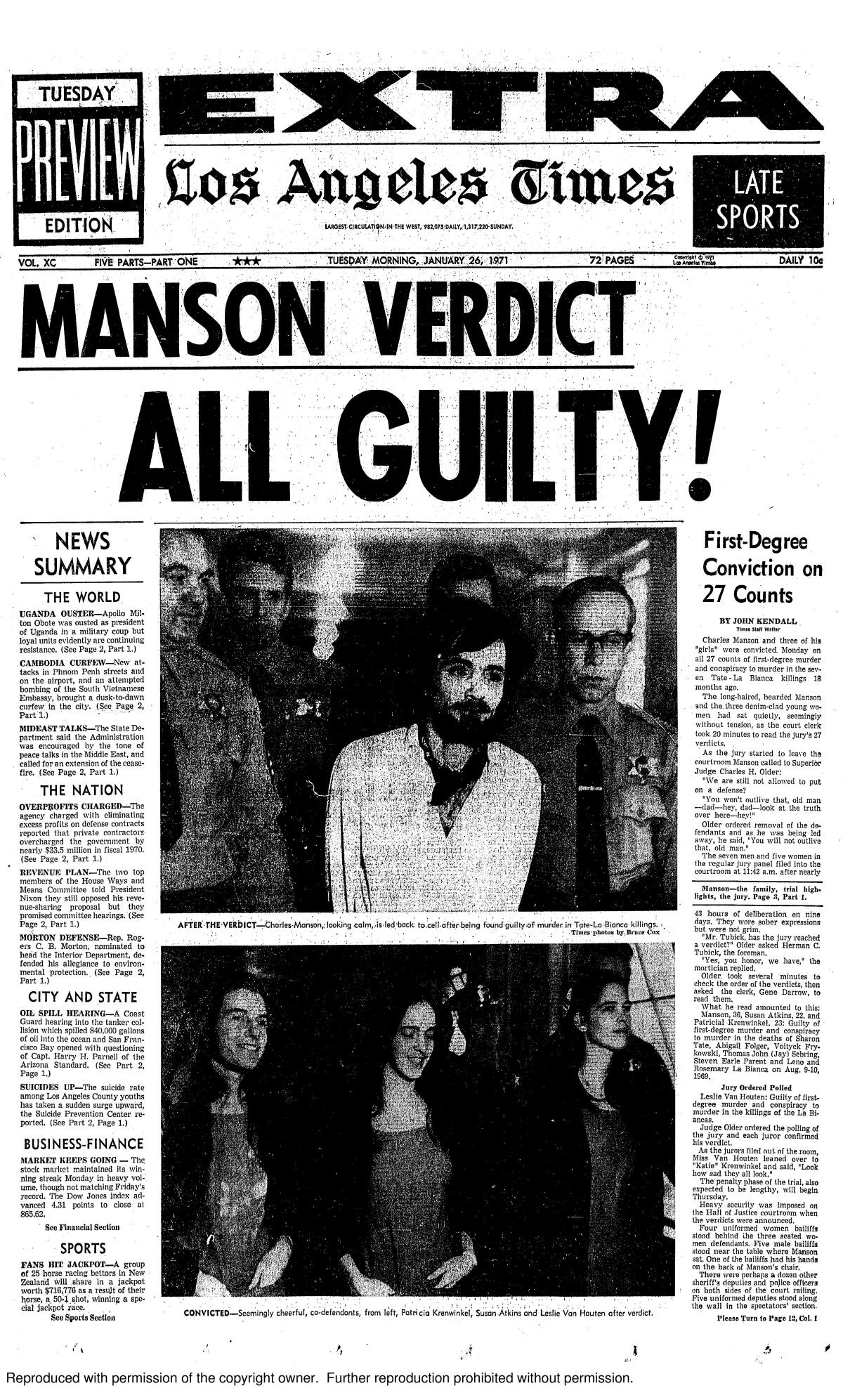
- Share via
This article appeared in the Los Angeles Times on Jan. 26, 1971.
Charles Manson and three of his “girls” were convicted Monday on all 27 counts of first-degree murder and conspiracy to murder in the seven Tate-La Bianca killings 18 months ago.
The long-haired, bearded Manson and the three denim-clad young women had sat quietly, seemingly without tension, as the court clerk took 20 minutes to read the jury’s 27 verdicts.
As the jury started to leave the courtroom Manson called to Superior Judge Charles H. Older:
“We are still not allowed to put on a defense?
“You won’t outlive that, old man — dad — hey, dad — look at the truth over here — hey!”
Older ordered removal of the defendants and as he was being led away, he said, “You will not outlive that, old man.”
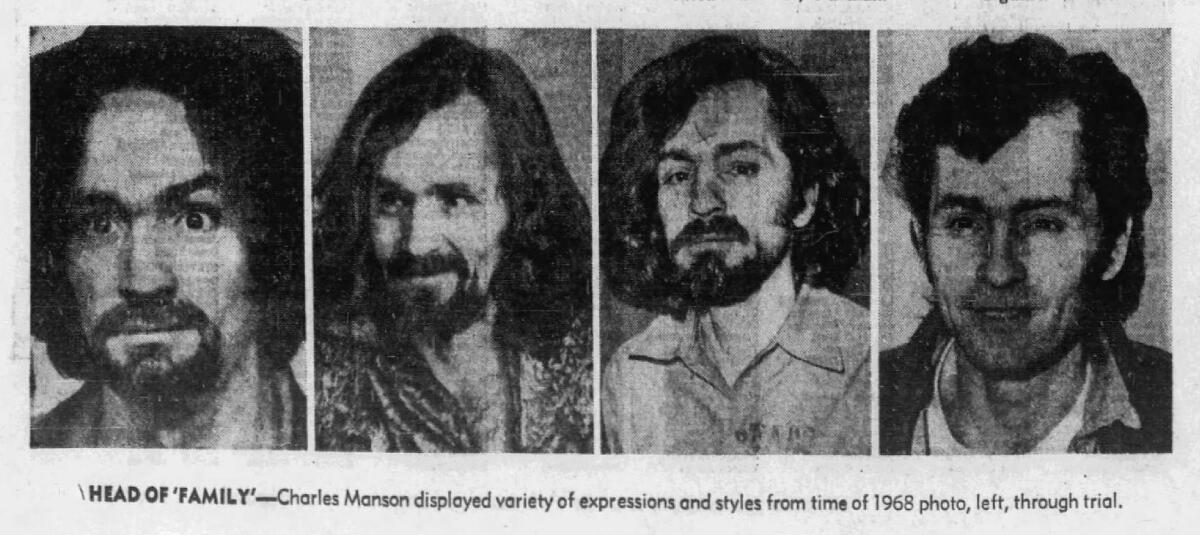
The seven men and five women in the regular jury panel filed into the courtroom at 11:42 a.m. after nearly 43 hours of deliberation on nine days. They wore sober expressions but were not grim.
“Mr. Tubick, has the jury reached a verdict?” Older asked Herman C. Tubick, the foreman.
“Yes, you honor, we have,” the mortician replied.
Older took several minutes to check the order of the verdicts, then asked the clerk, Gene Darrow, to read them.
What he read amounted to this: Manson, 36, Susan Atkins, 22, and Patricia Krenwinkel, 23: Guilty of first-degree murder and conspiracy to murder in the deaths of Sharon Tate, Abigail Folger, Voltyck Frykowski, Thomas John (Jay) Sebring, Steven Earle Parent and Leno and Rosemary La Bianca on Aug. 9-10, 1969.
Jury Ordered Polled
Leslie Van Houten: Guilty of first-degree murder and conspiracy to murder in the killings of the La Biancas.
Judge Older ordered the polling of the Jury and each juror confirmed his verdict.
As the jurors filed out of the room Miss Van Houten leaned over to “Katie” Krenwinkel and said, “Look how sad they all look.”
The penalty phase of the trial, also expected to be lengthy, will begin Thursday.
Heavy security was imposed on the Hall of Justice courtroom when the verdicts were announced.
Four uniformed women bailiffs stood behind the three seated women defendants. Five male bailiffs stood near the table where Manson sat. One of the bailiffs had his hands on the back of Manson’s chair.
There were perhaps a dozen other sheriff’s deputies and police officers on both sides of the court railing. Five uniformed deputies stood along the wall in the spectators’ section.
Everyone entering the building has been searched for several days because of rumors that there might be violence if Manson and the “girls” were convicted.
But there were no incidents in the audience. The bailiffs took the defendants back to their cells and after seven months the first phase of the trial was over.
This case, perhaps unparalleled in the annals of crime, is looked upon by many as a sociological phenomenon of our time.
The sequestered jurors, guarded at the Ambassador since July, 1970, now must decide on life or death in the penalty trial. They will continue to be locked up until it is over.
The prosecution will seek the death penalty, but prosecutor Vincent T. Bugliosi may rely solely on argument for it, without offering evidence of other possible crimes.
If, however, it is decided to offer evidence, Bugliosi is expected to present cases against Susan Atkins in the murder of musician Gary Hinman, and against Manson in the reported death of ranchhand Donald (Shorty) Shea.
The penalty phase could last from two days to two months, depending on the prosecution’s decision and the defense’s reaction to it.
Defense attorneys offered no defense in the guilt-or-innocence phase of the trial, relying on final arguments to attack the prosecution’s case. But they are ready to call witnesses in their clients’ behalf in a penalty trial.
The prosecution can be expected to argue in the hearing that if ever convicted murderers deserve death, they do in the Tate-La Bianca killings.
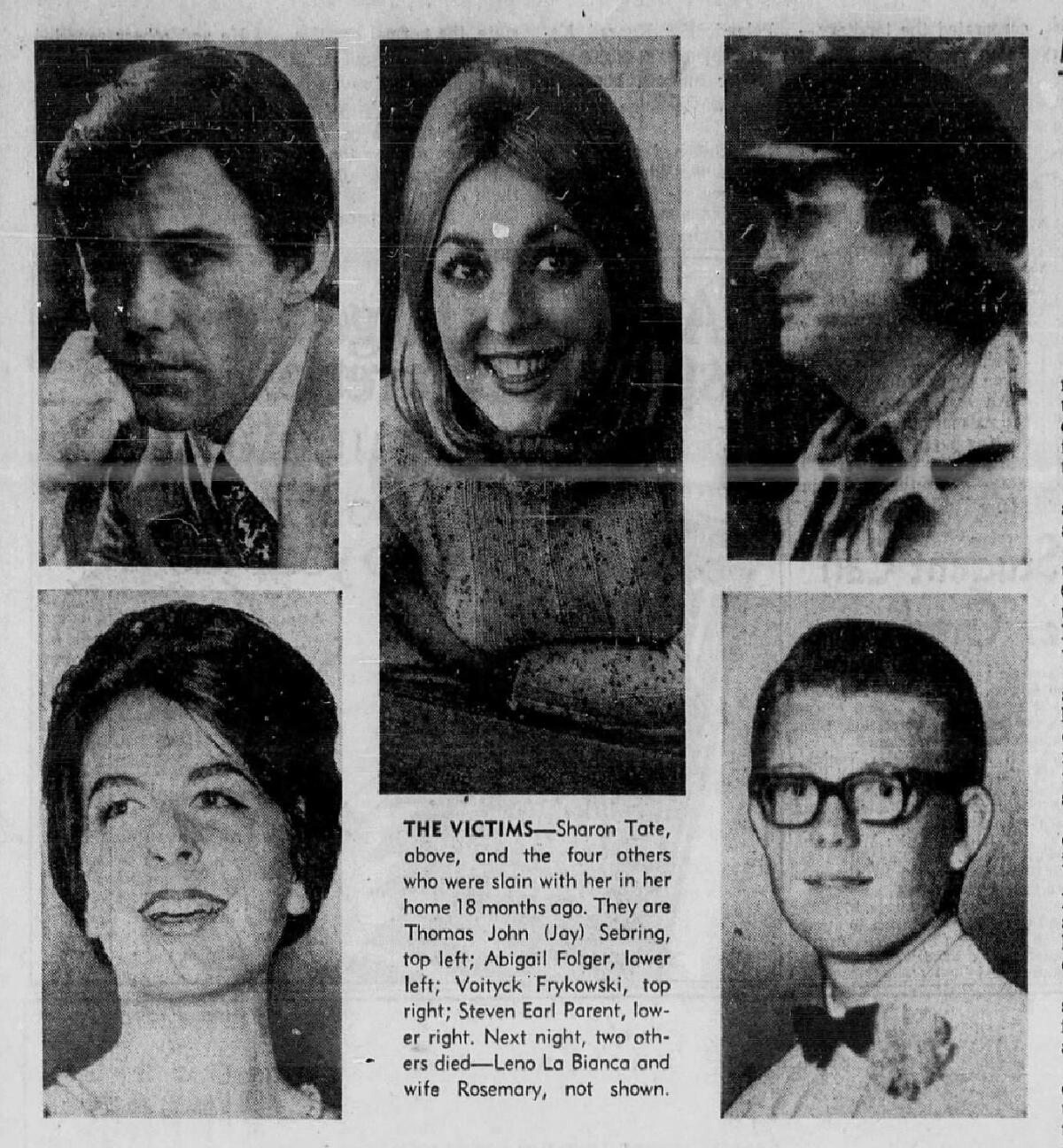
The five victims were stabbed a total of 102 times. One of them, Voityck Frykowski, was struck on the head 13 times, shot twice and stabbed 51 times.
The beautiful Sharon Tate, 27, was stabbed 16 times. Rope burns on her left cheek indicated she had been suspended by a nylon line thrown over a living-room beam and tied to her neck.
“Pig” was written on the front door in Miss Tate’s blood.
Next night, Bugliosi declared “it was Mr. and Mrs. La Bianca who were savagely butchered to death as a result of Charles Manson’s homicidal murderers.”
Leno La Bianca, 44, was found clad in pajamas on the living room floor of his Los Feliz district home. His hands were bound, a pillow case covered his head and he had been stabbed 26 times, “WAR” had been scratched on his abdomen, a carving fork protruded from his stomach and a 5-inch knife was embedded in his throat.”
The negligee-clad body of his 38-year-old wife, Rosemary, was found in a bedroom. Her head was hooded with a pillow case and her back had been cut to shreds. She had been stabbed 41 times.
“Death to Pigs” and “Rise” had been written in blood on the living room walls. “Healter Skelter” was smeared across the refrigerator door.
Overkill Question
“One hundred sixty-nine stab wounds!” cried Bugliosi in totaling the crimes. He asked jurors if the “overkill” didn’t show “willing participation” by the “killers.”
Bugliosi, who called 84 witnesses and introduced nearly 300 exhibits, argued that there was a “massive amount” of evidence demonstrating beyond doubt that Manson and his “girls” were “as guilty as sin.” He cited:
— Linda Kasabian’s story of the two nights of murder, including her eyewitness account of how Charles (Tex) Watson, a “family” member still waiting trial, shot young Steve Parent, how he battered and stabbed Frykowski and how “Katie” Krenwinkel chased “Gibby” Folger across the lawn with an upraised knife.
— “Sadie” Atkins’ statement to fellow inmates, Virginia Graham Castro and Ronni Howard, admitting the Tate murders; Manson’s statement to Juan Flynn, claiming responsibility “for all these killings,” and Leslie Van Houten and Miss Krenwinkel’s statements to former Manson follower Dianne Lake, implicating them in the La Bianca murders.
— Testimony by Los Angeles Police Department experts that a 22-caliber Longhorn Special revolver, found in a backyard about 3 ½ miles from the Tate residence, was the gun used to shoot Jay Sebring.
The gun was 5 connected with Spahn Ranch through comparison of markings on empty shell casings found in the weapon with empty casings found at the ranch, where Manson was seen with a similar revolver.
— Identification of fingerprints at the Tate house as belonging to Patricia Krenwinkel and “Tex” Watson.
Bugliosi cited much more which he said corroborated Mrs. Kasabian’s testimony, including three sets of circumstances which he suggested defy coincidence.
What are the chances, the prosecutor asked, that of all the homes in the Los Angeles area seven persons just happened to be murdered at two homes which testimony had shown Manson had visited?
Fingerprints Link
Or, what is the chance that of “several billion people” on earth, Mrs. Kasabian just happened to say that on the night of the Tate murders she was with persons whose fingerprints were found at the scene?
Or, that the blood writings, “Pig,” “Death to Pigs,” “Rise,” and “Healter Skelter” just happened to be the same words used by Manson and his “family” in discussing his philosophy and a predicted black-white war?
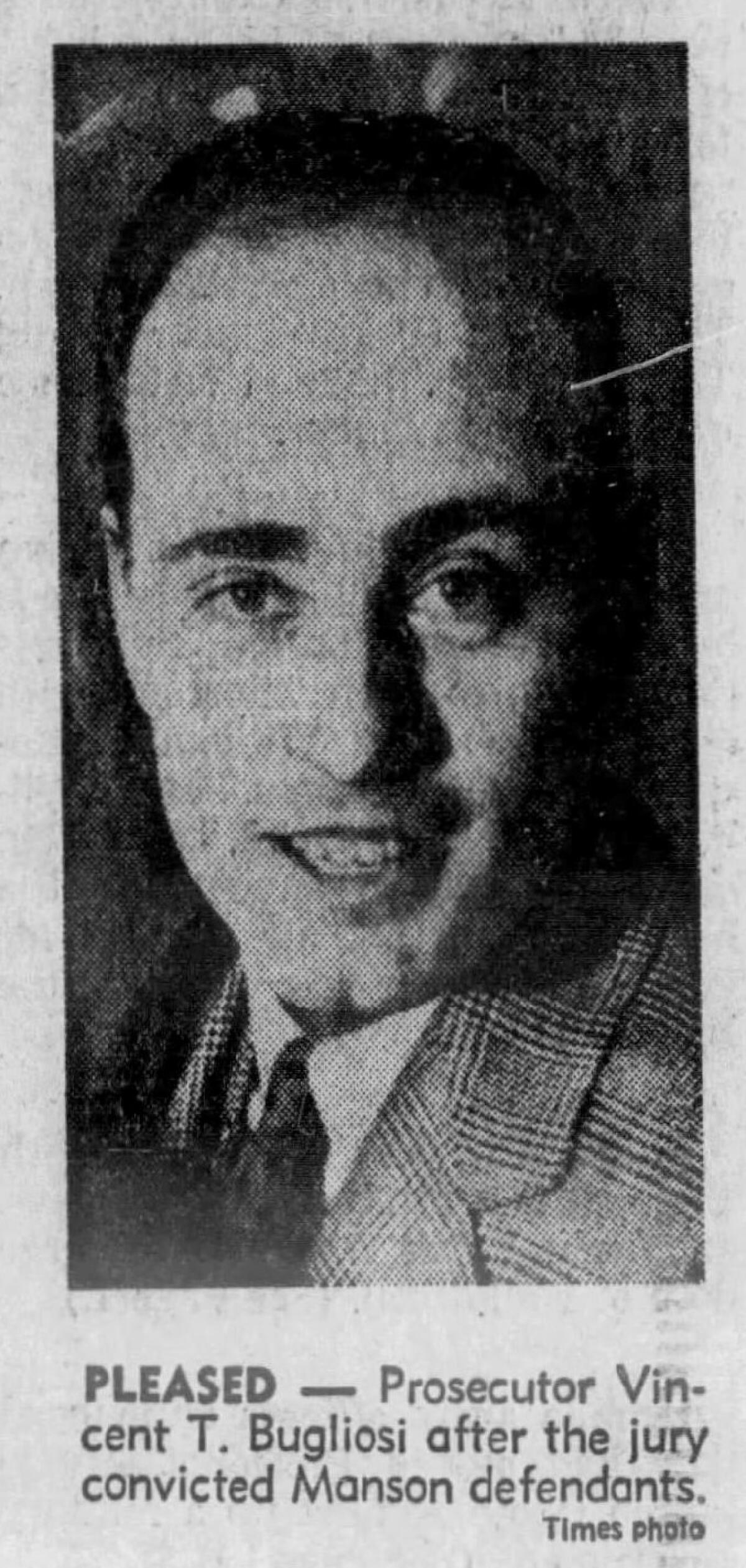
The prosecution never claimed Manson had killed any of the seven Tate-La Bianca victims, but Bugliosi centered his articulate, hard-hitting attack on the exconvict hippie leader.
He described Manson as a “polished, sophisticated conman,” someone with “a thousand faces” and a false face for everyone, a “guru” who dominated “family” members so completely he regulated their sex lives and a man who posed as a peace-loving hippie-type, but who, in reality, is a “vicious, coldblooded murderer.”
Next evening, he said, Manson led another murder mission to the La Bianca home to instruct his followers how it should be done because the first night had been “too messy.”
Manson’s motive, according to Bugliosi, was to start “Helter Skelter,” the defendant’s name for a black-white war which eventually would leave him and his “family” in charge.
The prosecutor said Manson was obsessed with the idea that Beatles songs such as “Helter Skelter,” “Piggies,” and “Revolution 9” forecast the impending doom of the white men.
“Piggies” has this refrain: “Everywhere there’s lots of piggies/living piggy lives/you can see them out for dinner/with their piggy wives/clutching forks and knives to eat their bacon.”
Grim Reminders
Jurors were reminded that Leno La Bianca was found with a fork in his stomach and a knife in his throat, and “Death to Pigs” had been written on the wall in blood.
One witness called by the prosecution because of his many conversations with Manson attributed to Manson an amoral philosophy decreeing that there is no right, no wrong, no good and no bad. In it, according to Gregg Jakobson, 30, pain and death are only man’s concepts and Manson is at once Jesus Christ and the devil.
‘Programmed’ Witnesses
Manson’s attorney, Irving A. Kanarek, rested his case without calling a witness, but he talked for seven full days about the prosecution’s case.
He said the trial was “political,” described it as a “lynching” and charged that the press had turned it into a Roman Circus.
Kanarek claimed Bugliosi was “hell bent” for conviction of Manson regardless of the obstacles, suggesting the prosecution had “programmed” witnesses and that it is “not inconceivable” that the .22-caliber revolver identified as the death weapon was a “fraud.”
The short, chunky lawyer argued that the prosecution had not corroborated Mrs. Kasabian’s testimony as legally required of an accomplice’s statement.
He said the state’s key witness had used drugs since she was 16, had been sexually promiscuous, had lied and had stolen $5,000 from a friend of her estranged husband.
False Testimony
Kanarek suggested that the sandy-haired, 21-year-old mother of two had falsely testified for the prosecution to gain the immunity granted her by the prosecution.
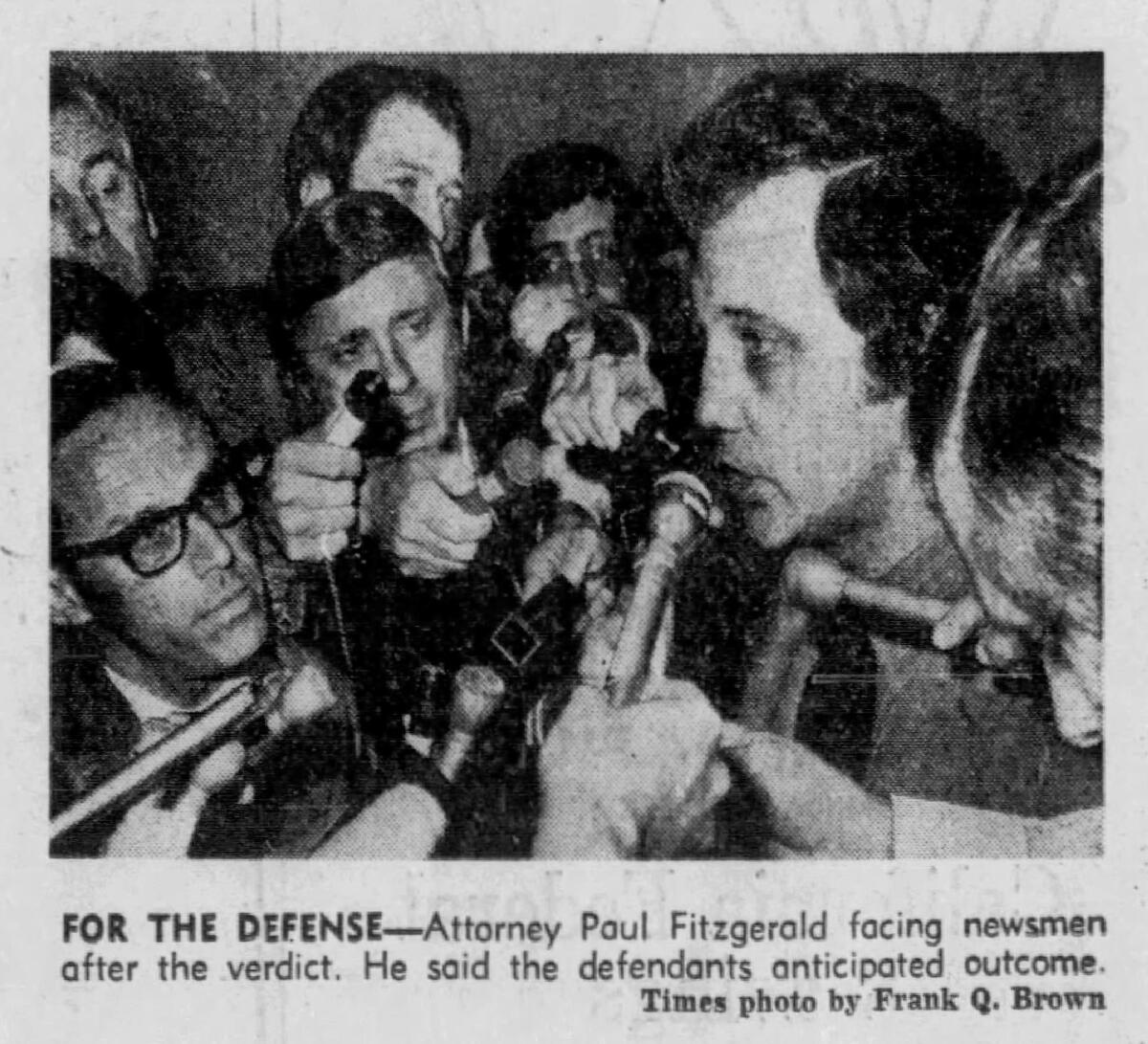
“Katie” Krenwinkel’s lawyer, Paul Fitzgerald, charged that Manson was being tried for breaking nearly all the Ten Commandments, not just on murder charges. He urged jurors to base their verdict on the “evidence and truth” and not on:
Running away from home, eating garbage, making love, being different, living in the desert, loving Charles Manson, hating others or teaching a radical philosophy.
Fitzgerald claimed that more than 70 black-and-white and color photographs of the seven victims in life, in death at the scenes and on the coroner’s autopsy table were a “panorama of gore” offered to create “enormous prejudice” in the jurors’ minds.
‘Grotesque’ Pictures
Bugliosi granted that the death pictures were “grotesque, gruesome, grisly and ghastly” but he contended the wounds they show demonstrate malice and premeditation and said: “If the defendants committed these murders ... the jury is entitled to look at their handiwork.”
The prosecutor denied that Manson and the others were being tried for their life-style or as examples of the nation’s social ills, but for “coldblooded murder.”
Manson’s “mistake,” he said, was sending “that little hippie girl, Linda Kasabian,” along on the evening of the Tate murders because she was a human being, not a savage killer.
Manson, himself, denied from the witness stand — without the jury present — that he was guilty. “I have killed no one and I have ordered no one to be killed,” he said.
“I may have implied on several occasions to several different people that I may have been Jesus Christ, but I haven’t decided yet what I am or who I am.”
Rare Monologue
It was an extraordinary monologue, delivered without prompting, about anything Manson had to say about the trial and his philosophy.
His appearance developed out of the decision of the defense attorneys to rest without putting on a defense. The defendants immediately insisted they wanted to put on a defense.
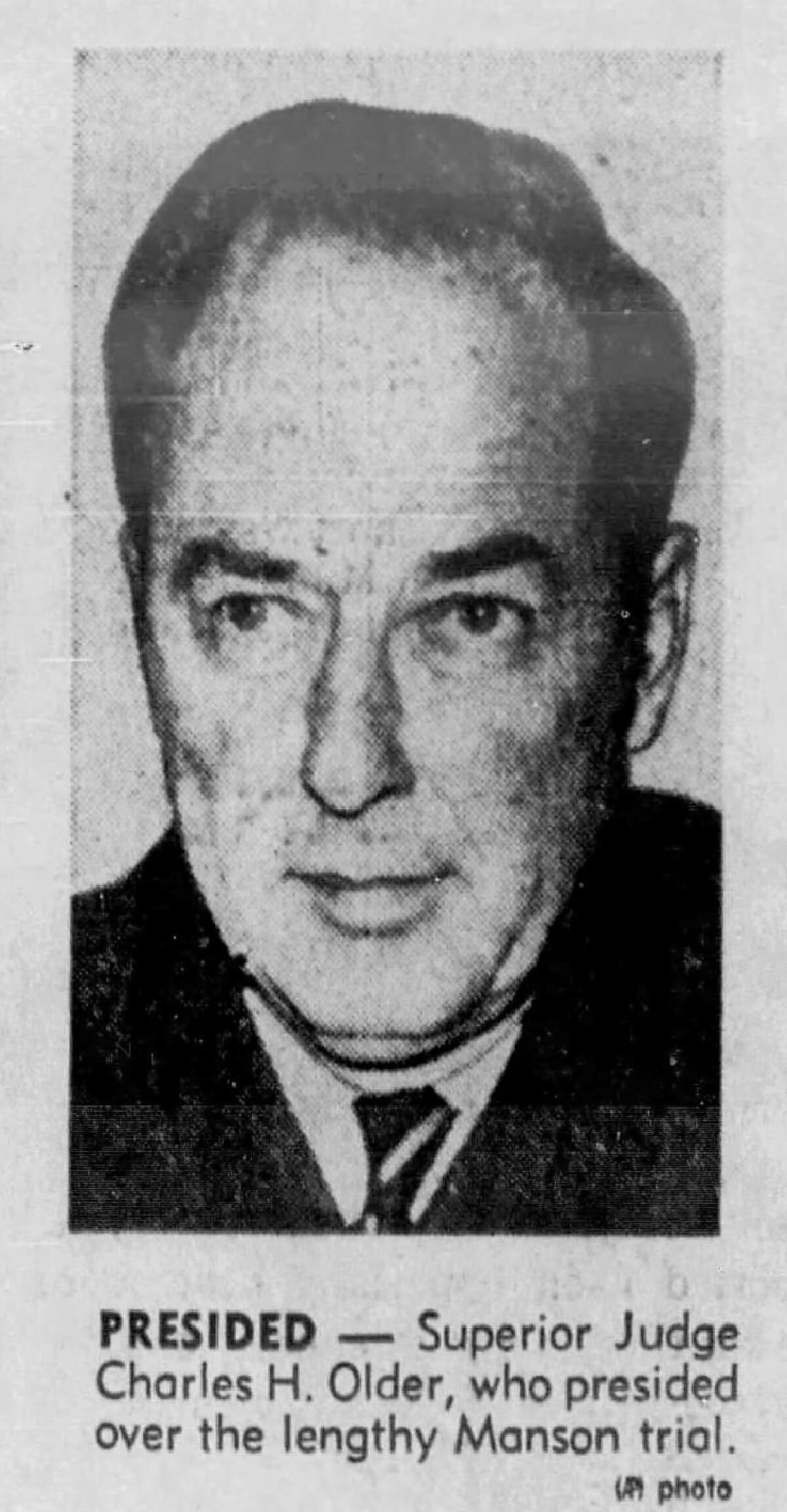
The three women defendants indicated they wanted to take the stand, and it was reported they were prepared to make judicial confessions, clearing Manson.
When Older indicated that the “girls” must first testify outside the jury’s presence, they refused. Manson accepted the offer.
When he was through, Manson left the witness stand and, as he walked past the three women defendants, he told them they didn’t have to testify.
All four then refused Older’s subsequent offer to testify before the jury.
Until the case went to the jury, however, they never stopped demanding that they be allowed to call witnesses and put on a defense.
Many Disruptions
The disruptions were frequent during the trial, and Manson and his “girls” spent long periods listening to the hearing by loudspeakers from adjoining rooms.
Manson continued to interrupt when he wasn’t in the courtroom by calling through the grille of a holding cell where he listened to the hearing.
Once when the prosecutor was telling jurors that Manson was a “vicious, diabolical murderer,” the defendant growled, “Grrhh.”
And, as the jurors filed out of the courtroom to begin deliberations, Manson called to Older, “Tell them why we couldn’t put on a defense, old man.”
More to Read
Sign up for Essential California
The most important California stories and recommendations in your inbox every morning.
You may occasionally receive promotional content from the Los Angeles Times.










